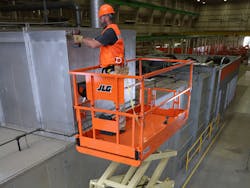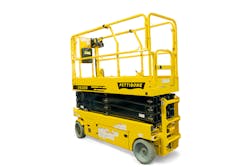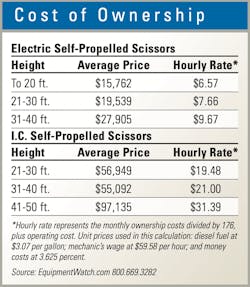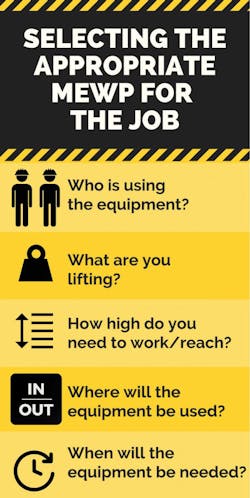The latest developments and innovations in the scissor lift Mobile Elevating Work Platform (MEWP) category revolve around operation in small footprints, an increasing number of electric models, and ease of maintenance, especially through telematics capabilities. There are also more manufacturers on the playing field.
The recent American Rental Association (ARA) show in Orlando was a window into what managers will soon be seeing on the market.
The ability to work within a smaller footprint is behind Snorkel’s North American launch of the S3019E. It has a patented design with a sunken scissor stack that stows entirely inside the chassis. It also has a low step-in height of 22 inches.
Snorkel says the machine is now available to order, and complies with the new ANSI/SIA A92.20 standards, which increase the minimum requirement for handrail height from 39 inches to 43.3 inches. Owing to the sunken stack, its low stowed height of 69.1 inches can pass through standard doorways without the need for folding guardrails.
Traditional category leaders Genie and JLG, and others, have been increasing the number of electric models they offer. Electric models, perfect for indoor use, are usually rechargeable electric or hybrid-powered.
As for ease-of-maintenance innovations, JLG used ARA to introduce a remote analyzer reader (RAR) for its MEWPs. RAR allows service departments to remotely assess a machine’s set-up and personalities to diagnose qualitative operational issues, check the on/off status of its connected technologies, or review its last 25 fault codes. This information is available in a single sheet summary format through its ClearSky telematics portal for most JLG scissor, boom, and telehandler models equipped with a CAN device.
“The ability for service technicians to gain this information in one overview report, then drill down to individual details on demand, gives them a wealth of equipment data right at their fingertips,” said Korry Kobel, JLG director of engineering. “This will allow service technicians to remotely diagnose a wide-range of reported machine issues from their existing location.”
Before the introduction of the RAR, Kobel says this level and type of performance and feature information required a technician to be next to a machine on a job site with a handheld analyzer.
“Depending on the diagnosis, they may or may not have had the tools and equipment needed in their service van to make the required adjustment or repair,” Kobel says. “With RAR, they can be more efficient in the use of their time before making a job site visit to ensure they arrive with the necessary materials to complete the work.”
With RAR, operators call a company service technician. The technician can then log into the ClearSky portal and enter the machine’s serial number to retrieve a summary report to better understand the set-up and performance of the machine.
“Ultimately, the ability to remotely analyze machines through RAR will help ClearSky portal customers maximize the uptime of their fleet,” Kobel says. “Having access to better and richer real-time data will help service departments be more efficient and focus their time on units requiring immediate attention.”
Existing ClearSky telematics portal customers will need to update the telematics software on their JLG machine CAN devices to enable the RAR feature.
There are also completely new entrants to the industry since CE last examined the category. In 2017, leveraging years of telehandler success, JCB launched a line of scissor lifts. Telehandler OEM Pettibone has also gone all-in on scissors. At this year’s ARA, Chinese manufacturer LiuGong threw its hat into the North American ring.
It launched two products, the LSC0607DE (platform: 5.8 meters; work height: 8 meters) and LSC1012DE (platform: 10 meters; work height: 12 meters). Both are CE certified and comply with ANSI standards, the company says. LiuGong will introduce four products into the North American market in the coming months.
No doubt the company is looking to cash in on the robust rental market. And electric scissor lifts are less costly to prepare for the North American market than heavy iron requiring Tier 4-F engines.
“LiuGong is very focused on serving the needs of the rental industry,” says Graziano Cassinelli, LiuGong’s global director of rental & used equipment. “Mobile elevating work platforms are the critical tool for rental customers to work safely above ground level, and China is predicted to become the largest market for MEWPs in the near future. We are pleased to be able to leverage the scale of the Chinese market for the benefit of our customers in North America and Europe.”
How to keep operating costs down for scissor lifts
Managers who choose to buy scissor lifts should take proactive steps to help keep operating costs low.
“First and foremost, keeping batteries charged and plugged in when not in use can help ensure that machines are ready to run when expected, ensuring maximum utilization,” says Michael Flanagan, Genie product manager, Terex AWP. “Additionally, a properly charged battery that is charged in a full cycle, as opposed to opportunity charging during lunchtime, for example, can help extend battery life.
“Batteries are one of the biggest costs associated with a slab scissor lift, so ensuring they are well maintained and watered in accordance with the operator’s manual can minimize battery replacement costs and downtime due to shortened battery life,” Flanagan says
“Also, it’s important to ensure operators are completing the required pre-operation inspections and function tests, in accordance with the operators’ manuals, to make sure the scissor lift is operating properly for maximum uptime.”
“There are a number of important considerations for both rental and end-user customers prior to purchasing a scissor lift,” Flanagan says. “Application or job site requirements may drive the initial direction with regard to machine make and model, so key specifications such as weight, length, width, and capacity, for example, should be crosschecked against the job.”
Flanagan also points to product support as an important factor. “A scissor lift is an investment, whether it is added to a rental fleet or to an owner/operator’s toolkit. As such, it is crucial for buyers to consider the history of the manufacturer. Aftermarket parts, service, and support are key considerations with respect to selecting a manufacturer. Total cost of ownership, quality, support, residual value, and more will be felt long after the purchase price is forgotten.”
MEWP manufacturer Haulotte publishes a handy guide on selecting the appropriate MEWP for the job. The company says using the wrong machine could damage the workplace, the equipment, or cause serious injuries. It urges managers to ask the following questions to determine the type of unit that best fits job site needs.
Who is using the equipment? Knowing the amount of people that need to be on the platform at once will help determine the platform size of the machine. Also, before work begins, do not forget to check the training level of the operators.
What’s being lifted? It is critical to estimate the load to be lifted in order not to exceed the lift capacity of the machine. This includes the weight of the material, tools, and operators.
How high do you need to work? Another important selection criterion for MEWPs is the working height. Have a look at the machine’s working envelope, which indicates the vertical height.
Where will the equipment be used? Location and ground conditions are key factors when choosing the right MEWP. Whether the work is indoors or outdoors impacts model (slab or rough-terrain) and power source selection. Another major point is the working area accessibility; some job sites have fixed obstacles, either on the ground or in the air, that may require specific machines. You also have to consider any specific restrictions, such as emission or noise, to identify the best equipment.
When will the equipment be needed? The required period impacts the serviceability of the machine. In the case of a long-term need, take into account maintenance needs, recharge, or onsite refuel capabilities.
Slab scissors for indoor jobs are hot right now. “The slab scissor lift market is strong now, and demand is not expected to decrease in the next 12 to 18 months, beyond the typical seasonality-induced peaks and valleys,” Flanagan says. “Scissor lifts continue to perform well with consistent year-over-year performance in most category classes.
“Growing demand across all industry segments is driving innovation with entirely new slab scissor lift models, as well as within specific areas of machine specification or operation,” Flanagan says. “At Genie, we’re focusing on our slab scissor lift offering on delivering on customer expectations, which means providing the product that meets the needs of the rental market and drives a high rental return on invested capital.”
How safe are scissor lifts?
Flanagan says safety regulations will continue to play a large role going forward.
“Updates to the ANSI and CSA standards in North America will result in a global standards commonality, driving innovation in systems that have historically been only regional requirements,” he says. “With scissor lifts, operators can expect the addition of active load sense systems similar to those that have been in place in European markets for the past few years. Additionally, changes to occupancy, capacity and/or height limitations can be expected, but these should not have a major impact to productivity.”
Industry veteran Chuck Yengst, president of Yengst & Associates, says industry sales in 2019 were in the range of 65,000 units, which was flat with 2018 sales. Sales over the past five years (since 2014) have improved about 25 percent. “The low point in sales for this product was 2009 at 7,000 units,” he says. “A plateau in sales occurred between 2012 and 2016, near 50,000 units.
“Looking ahead, the market may be flat to slightly higher in 2020 depending on how well the rental equipment industry fares,” Yengst says. “Beyond this election year, we look for sales to improve to higher levels above the current market demand, but that’s difficult to call since infrastructure and other items must be addressed at the national level, which cannot yet be determined.”








